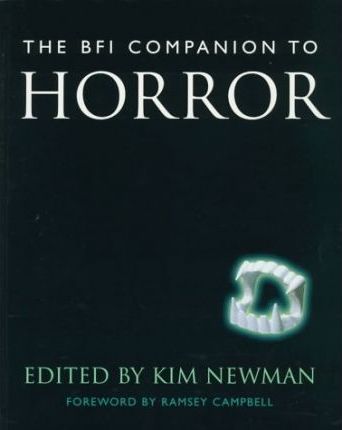|
The BFI Companion to Horror Book review by Thomas M. Sipos |
|
MENU Books Horror Film Festivals and Awards
Pursuits
Blogs Horror Film Festivals and Awards
Other
|
The BFI Companion to Horror (edited by Kim Newman,
Forward by Ramsey Campbell, 1997, 352 pp.)
Kim Newman explains in his Introduction: "A proliferation of guides offer this approach ... It wasn't thought necessary to duplicate their efforts." Newman is referring to to Phil Hardy's Aurum Encyclopedia: Horror. (Or as it's known in the United States, the Overlook Encyclopedia: Horror.) Hardy also contributes to The BFI Companion. Thirty-six contributors total, including Newman, and their aggregate credentials are impressive. Some have written for Sight and Sound, the BFI's magazine, but there's nothing especially British about this BFI book. India and Japan have their own entries. We learn the ghost story is very big in Japan, and because ghost story is bold-faced we know it has its own entry. Entries exist for films, TV shows, radio shows, publications (Fangoria, Pan Book of Horror Stories, EC Comics), directors, writers (screenwriters as well as novelists from past centuries), critics, composers, characters (Elvira, Vampira, Vampirella, Van Helsing), techniques (Image Animation). Only seminal films have entries; you won't find obscurities (why was House deemed worthy of inclusion and so many others not? -- because Sean Cunningham produced it?). Such tangential horror folk as Kafka, Fellini, Bergman, and Disney are included. Because most B actors are excluded, one wonders why Suzy Kendell and Meg Foster are in. They have horror credits, but so too Cathy Lee Crosby and June Chadwick. One problem with a work of such wide-ranging scope -- all of horror -- is that selections are bound to be arbitrary rather than definitive. This is especially true of theme. Not surprisingly, there's an entry for Vampirism (actually two entries, one "Before Dracula," one "After Dracula") but who would think to look up "Disfigurement and Plastic Surgery" or "The Military"? Such entries make The BFI Companion fun to browse, but less useful as a reference. You wouldn't think of the entry until you saw it. Helpfully, if you look up Slasher, you're referred to "Stalk and Slash." Some themes overlap. Violence and Torture have separate entries, as do Rape, Sex, Incest, and Pornography. Other entries include: Dogs, Dolls, Eyes, Heads, Jungle, Immorality, Victims, Minions (e.g. Ygor or Renfield), Serial Murder, Mutation, Dreams, Giallo, Heroines, Disease. A broad smorgasbord. Still, the book emphasizes cinematic horror. How a theme has functioned in horror films. How a novelist's works have been translated to film. Some entries evince a British perspective. Under "The Military" we read that films about soldiers confirm "a continuing rejection of militarism in all its forms." Contributor Philip Strick cites both British and American films to support his point, but I suspect he more accurately captures Brit rather than Yank sensibilities. American films have portrayed the US military across the spectrum, from barbaric (Soldier Blue) to romantic (Top Gun). I know that Strick wrote this entry because all entries are initialed by their contributor -- a nice feature. 
Kim Newman is well suited to research. Aside from Nightmare Movies, he wrote the extensively researched Great War dark fantasy novel, The Bloody Red Baron. Yet I find fault with some of The BFI Companion's entries. Erzsébet Báthory is described as a "Slovakian mass murderess." But as McNally and Florescu state in In Search of Dracula, though Báthory's estate was in present day Slovakia, she herself was a Hungarian (Magyar) aristocrat. Not a trivial point; she was able to kill with impunity partlially because she was a Hungarian noble who initially victimized only the surrounding Slovak peasantry. McNally also wrote the Báthory biography, Dracula Was a Woman. Another error: Newman's entry for Fritz Leiber cites "the horror novel Conjure Wife (1943)." Yet Leiber only completed the short story in 1943; the novel wasn't published until 1953. Contributor Mike Wathen's entry for "The Ghost Story" provides the correct year. More leeway exists for critical assessments. Newman is half right about Lloyd Kaufman: "Mastermind of the dumbing of American horror." Newman would be closer to the truth if he instead said, "dumbing of American exploitation," because it's Kaufman's earlier, lesser known, horror films (Mother's Day, Splatter University) that have the most merit, and the most genre integrity. The BFI Companion is lavishly illustrated, doubtless drawing upon the BFI's archives. Even better, many of the stills are not the usual suspects. Some publishers have a practice of releasing oversized and overpriced horror film books containing scant pages, rehashed text, and photos we've seen all too often. Happily, effort seems to have been expended toward illustrating The BFI Companion with rarely seen stills. An attractive book printed on high quality paper, informative and absorbing. |
"Communist Vampires" and "CommunistVampires.com" trademarks are currently unregistered, but pending registration upon need for protection against improper use. The idea of marketing these terms as a commodity is a protected idea under the Lanham Act. 15 U.S.C. s 1114(1) (1994) (defining a trademark infringement claim when the plaintiff has a registered mark); 15 U.S.C. s 1125(a) (1994) (defining an action for unfair competition in the context of trademark infringement when the plaintiff holds an unregistered mark).font>


 Although
published in association with the British Film Institute,
Although
published in association with the British Film Institute,
